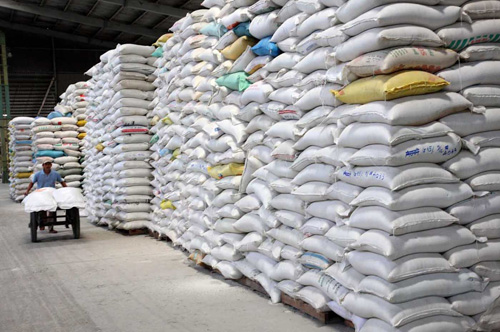Circular 78: Guidelines for the process of importing rice into the national reserve warehouse
Recently, the Minister of Finance of Vietnam has signed and issued Circular 78/2019/TT-BTC on the National Technical Regulation for National Reserve Rice.
The procedure for importing rice into the national reserve warehouse is carried out according to the "National Technical Regulation for Rice of the National Reserve" issued with Circular 78/2019/TT-BTC, specifically including the following steps:

Illustration (Source: Internet)
Step 1: Preparing the warehouse
- Flatten the warehouse floor and walls.
- Clean and disinfect the warehouse and materials used to store the rice: Sheets, pallets, rice unloading bridges...
Step 2: Technical processing and forming of PVC storage bags:
- The sealed storage bags for the rice batch are made from PVC film, including a cover sheet and a floor sheet. The length and width of the bag should be at least 20 cm larger than the size of the rice block, and the height of the bag should be between 20 cm and 30 cm taller than the height of the rice block.
- Spread the floor sheet and arrange the pallets (if any).
+ Carefully check the floor surface and the seams of the floor sheet.
+ Spread the floor sheet flat at the predetermined position of the rice batch.
+ In case pallets are used, the pallets should be firmly placed on the floor sheet, maintaining an equal distance of 25 cm to 30 cm from the edges. When arranging, adjust the pallets gently without dragging or pulling them to avoid scratching or tearing the film. Until the rice batch is sealed, the surrounding base film should be rolled up to avoid stepping on and contaminating it.
- The cover sheet is sealed with the floor sheet after the rice batch is fully imported.
Step 3: Inspection upon warehouse entry
- Check related documents and records: The rice batch transferred to the warehouse must be accompanied by a Certification of Conformance ensuring it meets the quality standards for warehousing according to Section 2.1 of this Regulation, issued by an authorized organization or unit.
- Check packaging and the volume of rice imported:
+ Inspect the packaging according to point 4.2.7 and the signed contract.
+ The rice is weighed 100% or by inspection according to the agreement of the parties. The total amount of rice delivered and received must match the quantity specified in the contract.
+ The warehouse keeper must monitor and accurately record the amount of rice imported according to the regulations.
- Quality sample inspection of the batch: After verifying the requirements specified in items 4.3.3.1 and 4.3.3.2, the national reserve unit technician takes representative samples of the batch as per article 3.1 Section 3 of the Regulation. The technician examines and analyzes the quality criteria of the rice according to points 2.1.1 and 2.1.2 of Section 2.1 of the Regulation.
Step 4: Arranging rice in the warehouse
- Rice bags should be neatly arranged in straight rows so the surface of the batch is not uneven. The first layer of bags should extend out from the pallet edges by 5 cm to 10 cm (ensuring the pallet edges do not rub against the PVC film). Upper rows should gradually taper inwards so that the top of the batch forms an angle of 3° to 5° with the base. The openings of the bags should not face outward.
- Bags should not be overlapped to create gaps for the gas to be evenly distributed throughout the batch.
- In the same layer, the bags should be interlocked (see diagram). The entire batch, once arranged, should be firm and stable, preventing any tilting or collapse during storage.
- Rice should be stacked in batches, each with a weight not exceeding 300 tons depending on the size and type of warehouse. The topmost layer should be at least 1.5 m away from the ceiling. The batch should be at least 0.5 m from the wall and at least 0.8 m from other batches. If pallets are not used, the bags in the bottom layer should be spaced 3 cm to 5 cm apart to ensure ventilation.
.gif)

| First layer (odd layer) | Second layer (even layer) |
Refer to the full text of the regulations in Circular 78/2019/TT-BTC, effective from January 1, 2020.
Thu Ba
- Number of deputy directors of departments in Vietnam in accordance with Decree 45/2025/ND-CP
- Cases ineligible for pardon in Vietnam in 2025
- Decree 50/2025 amending Decree 151/2017 on the management of public assets in Vietnam
- Circular 07/2025 amending Circular 02/2022 on the Law on Environmental Protection in Vietnam
- Adjustment to the organizational structure of the Ministry of Health of Vietnam: Certain agencies are no longer listed in the organizational structure
- Vietnam aims to welcome 22-23 million international tourists in Vietnam in 2025
-

- Notable new policies of Vietnam effective as of ...
- 16:26, 11/04/2025
-
.Medium.png)
- Notable documents of Vietnam in the previous week ...
- 16:21, 11/04/2025
-
.Medium.png)
- Notable documents of Vietnam in the previous week ...
- 16:11, 02/04/2025
-
.Medium.png)
- Notable new policies of Vietnam to be effective ...
- 16:04, 02/04/2025
-
.Medium.png)
- Notable new policies of Vietnam effective from ...
- 14:51, 21/03/2025
 Article table of contents
Article table of contents
